With much of the world at war, a Port Kembla-based historian, activist and academic, Alexander Brown, posed the question "How can we make Wollongong a city of peace?" during his address at Wollongong Library on Monday night.
In a wide-ranging talk, Alexander told a crowd of more than 100 that Wollongong can stand tall, as a city that has always strived for peace.
"This is a city that has in part been defined by its peace activism," Alexander said. "To me, being a city of peace is an aspiration, something we should all head towards."
Marking 80 years since the bombing of Hiroshima, our central city library is playing host to displays, a photographic exhibition and talks that explore Wollongong's place in the history of the peace movement.
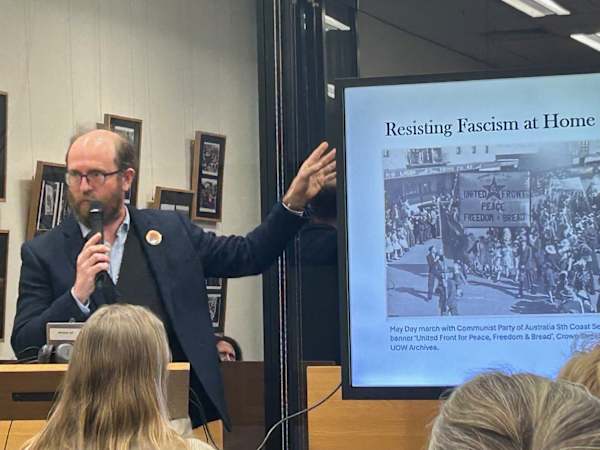
Bloodshed in the Frontier Wars
Alexander began his talk in a time when there was violence not peace, in the early 1800s and the so-called Frontier Wars.
"Our city of peace is based on a history of colonial violence," Alexander said. "It's estimated 500 Aboriginal people were killed here in the Frontier Wars.
He described the harrowing scenes during the Appin Massacre resulting in the mass murder of Aboriginal men, women and children on 17 April 1816. The massacre resulted in the loss of a large number of the local Dharawal people in what's reported to be the first military-ordered massacre of Aboriginal people in Australia.
In 1830, he said an estimated 100 people died in another bloody conflict, the Battle of Fairy Meadow.
The outbreak of World War One saw the creation of a strong anti-conscription movement in Wollongong and when the Prime Minister of the day, Billy Hughes, brought on a referendum, Alexander said Wollongong had a higher NO vote than the national figure (much as in 2023, Wollongong recorded a higher YES vote for the Indigenous Voice to Parliament).
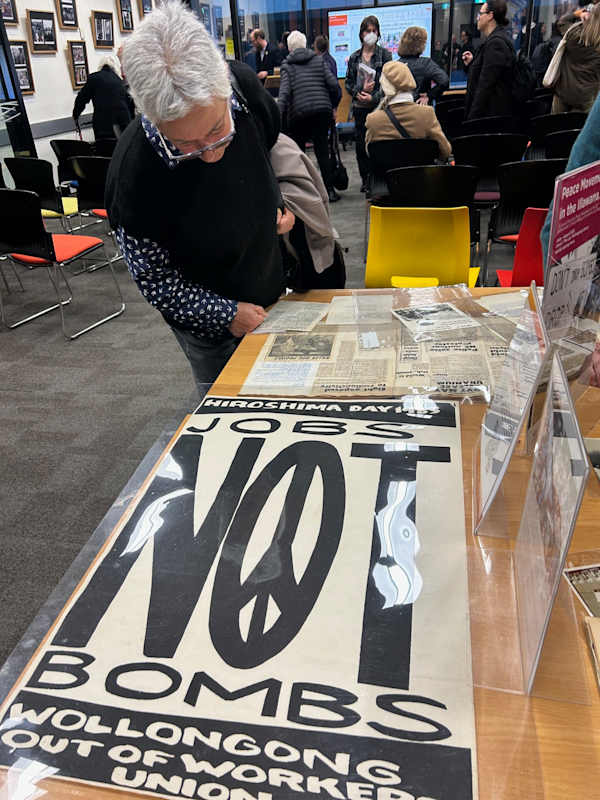
Waterfront lockout at Port Kembla
Alexander said on the eve of World War Two, Wollongong found itself at the centre of a major political industrial dispute. It followed atrocities committed over several weeks from December 1937 by the Imperial Japanese Army in Nanjing, the then capital of China, in which up to 200,000 mainly civilians and prisoners of war were killed.
When the steamship 'Dalfram' docked in Port Kembla on 15 November 1938 to load pig iron to Japan, the Waterside Workers' Federation urged their union members not to load the iron, telling them it would be used to produce weapons to be used against the Chinese, and perhaps ultimately against Australia. The following day not a single worker put themselves forward to load the ship, sparking an 11-week lock out.
The Dalfram Dispute was one of the most important campaigns in the history of Australia's Waterside Workers' Federation. On 11 January 1939, then Attorney General, Robert Menzies, visited Wollongong in an attempt to resolve the dispute. The locals were ready for him, and he was met by a hostile crowd of more than 1000 people. It was at this meeting that Gwendoline Croft, from the Waterside Workers' Women's Committee, shouted out 'Pig Iron Bob' at Menzies, thus earning him that enduring nickname.
In his address, Alexander referred to the removal of an Aboriginal community at Port Kembla's Hill 60 during World War Two when it became heavily militarised and fortified as a crucial defence installation for Port Kembla's industrial area.
He said the significant site for First Nations' People was supposed to be handed back to the local Aboriginal community once the war was over but the defence department sold it to Wollongong Council for $1 (a pound).
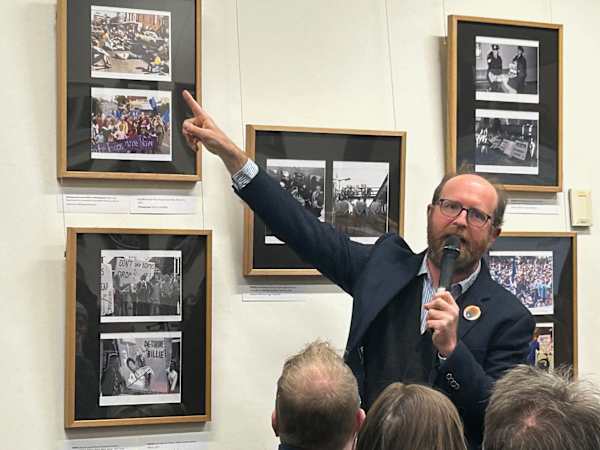
Protests and arrests during the Vietnam War
During the Vietnam War in Wollongong a 'Save Our Sons' group was formed by women to oppose conscription.
"In April 1969 during a protest at Wollongong railway station, Louie Christofides sat on the railway tracks to prevent the departure of conscripts. Louie was jailed for his actions," Alexander said.
What followed were big moratorium marches in the city and members of Save Our Sons travelled to Canberra where they disrupted Federal Parliament by chaining themselves to the public gallery.
In the years that followed, Wollongong declared itself a Nuclear Free Zone and in 1986, to mark the International Year of Peace, 1000 people attended a Peace March through the heart of the city.
In the 2000s, Alexander said there was a growing sense of a threat of a nuclear war.
On 8 February 2003, about 5000 people joined a 'No War March' in Wollongong "the largest march in Wollongong so far" to protest the invasion of Iraq.
"In the 2000s there have also been protests at the University of Wollongong against defence recruitment and arms deals at UOW careers fairs," Alexander said.
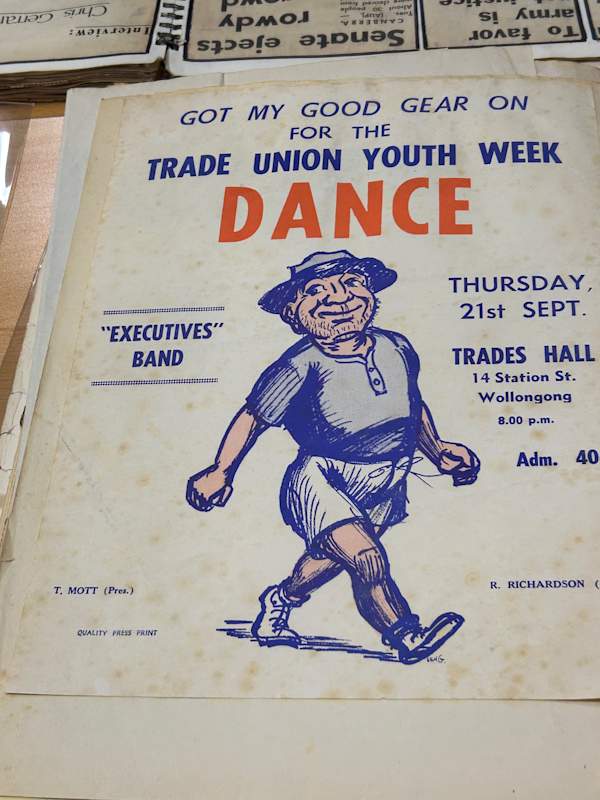
AUKUS nuclear sub deal sees peace movement reborn
Today, he said, the role of the peace movement in Wollongong is more important than ever. The announcement of the AUKUS nuclear submarine deal in 2021 "was the rebirth of the peace movement here" and gave rise to the formation of Wollongong Against War And Nukes (WAWAN).
"The 2023 May Day march saw 1000 people come out to say no to AUKUS and any plans to create an east coast nuclear submarine base at Port Kembla," Alexander said.
"With AUKUS, Wollongong is being offered more polluting industry, continuing climate chaos, and a future as a military-industrial outpost for a declining empire amidst a world at war.
"And, of course, we have ongoing solidarity with the people of Palestine with weekly demonstrations in the mall, organised by the Friends of Palestine."
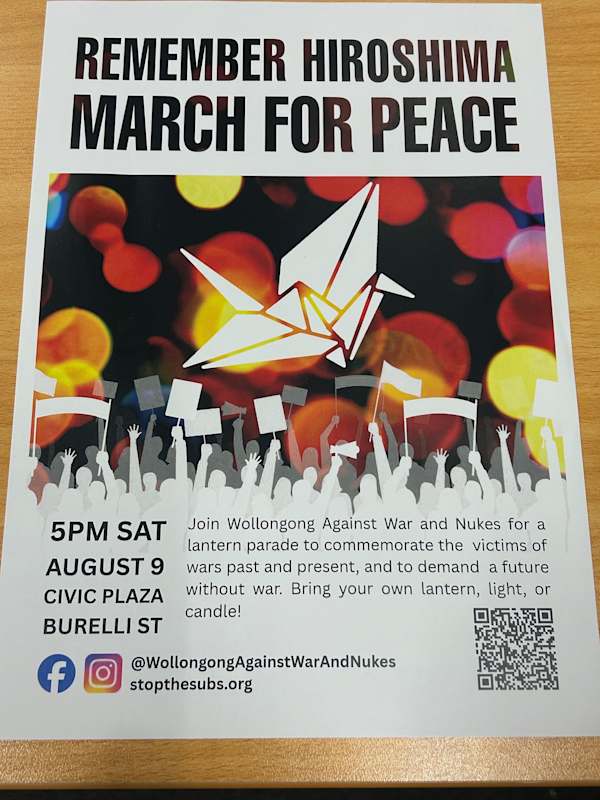
Ongoing protests this week against the war in Gaza
Just this week, a picket at Unanderra's Bisalloy Steels has disrupted production of steel products that protestors say are being sold to Israel to boost their war efforts in Gaza.
"We commend Wollongong Council for renewing its recent commitment to peace and a nuclear-free future at the Council meeting on 16 June 2025," Alexander said. "The Wollongong peace movement is a movement of the heart; the alternative to war is love and peace. It's something we aspire for, we live, and we have to fight for."
During his address, Alexander launched his new booklet, Wollongong: City of Peace as part of WAWAN's two-week activist residency at Wollongong Art Gallery. There are also displays in the Wollongong City Library, culminating in the 'Remember Hiroshima March for Peace' lantern display, which will take place from 5pm on Saturday, 9 August in Civic Plaza outside IPAC.






